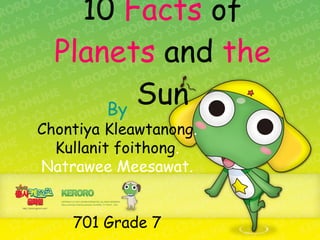
Sun nn
- 1. 10 Facts of Planets and the Sun By Chontiya Kleawtanong . Kullanit foithong . Natrawee Meesawat. 701 Grade 7
- 2. T h e S u n The Sun is one out of billions of stars . The Sun is the closest star to Earth . The Sun rotates once every 27 days . The Sun is now a middle - aged star, meaning it is at about the middle of its life . The Sun formed over four and a half billion years ago . You may think the Sun will die soon, but it will keep shining for at least another five billion years .
- 3. M e r c u r y Mercury is the innermost and smallest planet in the Solar System . orbiting the Sun once every 87.969 Earth days .
- 4. V e n u s Venus is known as Earths' twin sister because of its similar size and proximity to each other . Its atmosphere is made up mostly of carbon dioxide.
- 5. E a r t h The Earth is not actually round in shape; in fact it is geoid. This simply means that the rounded shape has a slight bulge towards the equator.
- 6. M a r s Mars has the largest canyon in the solar sys tem . It would reach from Los Angeles to Chicago if it was on Earth ! Mars has a very thin atmosphere, mostly carbon dioxide, but dust storms ca n cover the whole planet for months at a time . About every two years the Earth and Mars come close together . The planet has two moons, Deimos and Phobos .
- 7. Jupiter Jupiter takes about 12 years to orbit the sun and rotates in about 10 hours . This short Jupiter " day " is amazing since the planet is roughly 11 Earth diameters wide . Unlike the rocky planets, Jupiter is a ball of dense hydrogen, helium, water, nitrogen and other gases over a tiny rocky core . Powerful winds dominate the atmosphere with criss - crossing jet streams, lightning and huge hurricane - like storms like the Great Red Spot .
- 8. S a t u r n The icy planet Uranus is a smaller version of Jupiter and not the small rocky bodies like Earth . It have faint rings and a number of moons . Uranus takes some 84 years to orbit the sun . It rotates on its side and so half the time one pole is toward the sun and then the other making each of the four seasons last about 20 years . The faint bluish color of the planet is because the methane gas in the atmosphere absorbs red light and reflects blue light .
- 9. U r a n u s Neptune is the eight planet from the Sun in our solar system. Here are collection of fact about Neptune available to us through astronomy and scientific research.
- 10. N e p t u n e Neptune is the eight planet from the Sun in our solar system . Here are collection of fact about Neptune available to us through astronomy and scientific research .
- 11. P l u t o Pluto is the farthest planet from the Sun and by far the smallest. Pluto is smaller than seven of the solar systems moons
- 12. Thank you for looking my group .